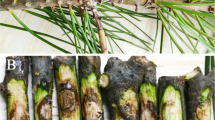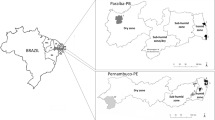Abstract
Sanhua plum (Prunus salicina), native to Guangdong Province, China, is a highly valued fruit tree because of the fruit's characteristic taste and excellent nutritional properties. A severe blighting of shoots of Sanhua plum was observed at local Sanhua orchards in Guangdong Province from 2019 to 2021, which weakens the tree vigour and reduces the fruit yield. This study aimed to characterize the symptoms of Sanhua plum leaf blight and shoot dieback, evaluate the incidence and impact, and identify the causal agent and evaluate its pathogenicity. The disease was present in all three Sanhua orchards surveyed (a total of 29 hectares), but incidence varied with locations and years, ranging from 0.4% to 3.7%. An oomycete species was isolated from symptomatic shoots collected from the surveyed fields. Based on morphological and cultural characteristics and combined phylogenetic analysis of two molecular markers, including the internal transcribed spacer regions (ITS) of rDNA and Ras-related Ypt1 gene, 15 isolates were identified as belonging to the species Phytophthora nicotianae. The isolates were pathogenic to Sanhua plum plants in nursery experiments, and symptoms identical to that observed in the fields were reproduced. The pathogen was isolated consistently from the inoculated plants, confirming Koch's postulates. Shoot blight caused by P. nicotianae represents a new threat to Sanhua plum productivity and longevity in southern China.






Similar content being viewed by others
Data Availability
The sequences produced in this study have been deposited into NCBI GenBank and can be accessed using the accession numbers listed in Table 2.
References
An, K., Wu, J., Tang, D., Wen, J., Fu, M., Xiao, G., et al. (2018). Effect of carbonic maceration (CM) on mass transfer characteristics and quality attributes of Sanhua plum (Prunus salicina Lindl.). LWT-Food Science & Technology, 87, 537–545.
Arroyo, F. T., Camacho, M., & Daza, A. (2012). First report of fruit rot on plum caused by Monilinia fructicola at Alcalá del Río (Seville), southwestern Spain. Plant Disease, 96, 590.
Chang, T., Hassan, O., & Lee, Y. S. (2018). First report of anthracnose of Japanese plum (Prunus salicina) caused by Colletotrichum nymphaeae in Korea. Plant Disease, 102, 1461.
Chen, X. R., Xing, Y. P., Li, Y. P., Tong, Y. H., & Xu, J. Y. (2013). RNA-Seq reveals infection-related gene expression changes in Phytophthora capsici. PLoS ONE, 8, e74588.
Chen, G. L., Chen, S. G., Zhao, Y. Y., Luo, C. X., Li, J., & Gao, Y. Q. (2014a). Total phenolic contents of 33 fruits and their antioxidant capacities before and after in vitro digestion. Industrial Crops and Products, 57, 150–157.
Chen, X. R., Zhang, B. Y., Xing, Y. P., Li, Q. Y., Li, Y. P., Tong, Y. H., et al. (2014b). Transcriptomic analysis of the phytopathogenic oomycete Phytophthora cactorum provides insights into infection-related effectors. BMC Genomics, 15, 980.
Chen, X. R., Liu, B. B., Xing, Y. P., Cheng, B. P., Liu, M. L., Tong, Y. H., et al. (2016). Identification and characterization of Phytopythium helicoides causing stem rot of Shatangju mandarin seedlings in China. European Journal of Plant Pathology, 146, 715–727.
Chen, J. S., Miao, Y. T., Zhang, P., & Liu, D. W. (2018). Investigation of plum red spot in Changchun and Harbin. Heilongjiang Agricultural Science, 4, 54–56.
Crepel, C., & Inghelbrecht, S. (2002). First record of leaf spots on Prunus laurocerasus in Belgium caused by Phytophthora cactorum and Peronospora sparsa. Plant Disease, 86, 563.
Elliott, M., Rollins, L., Bourret, T., & Chastagner, G. (2021). First report of leaf blight caused by Phytophthora ramorum on cherry laurel (Prunus laurocerasus) in Washington State, USA. Plant Disease, 105, 712.
Erwin, D. C., & Ribeiro, O. K. (1996). Phytophthora diseases worldwide. APS Press.
Ferrada, E. E., Díaz, G. A., Zoffoli, J. P., & Latorre, B. A. (2014). First report of blossom blight caused by Sclerotinia sclerotiorum on Japanese plum, nectarine, and sweet cherry orchards in Chile. Plant Disease, 98, 695.
Ferrada, E. E., Latorre, B. A., Zoffoli, J. P., & Castillo, A. (2016). Identification and characterization of Botrytis blossom blight of Japanese plums caused by Botrytis cinerea and B. prunorum sp. nov. in Chile. Phytopathology, 106, 155–165.
Ginetti, B., Carmignani, S., Ragazzi, A., & Moricca, S. (2014). Phytophthora taxon Pgchlamydo is a cause of shoot blight and root and collar rot of Viburnum tinus in Italy. Plant Disease, 98, 1432.
Hong, C. X., Richardson, P. A., & Kong, P. (2005). Shoot blight of Forsythia × intermedia in Virginia nurseries caused by Phytophthora nicotianae. Plant Disease, 89, 430.
Huang, J. H., Ann, P. J., Chiu, Y. H., & Tsai, J. N. (2012). First report of Phytophthora cambivora causing leaf and stem blight and root rot on Taiwan cherry (Prunus campanulata) in Taiwan. Plant Disease, 96, 1065.
Igwe, E. O., & Charlton, K. E. (2016). A systematic review on the health effects of plums (Prunus domestica and Prunus salicina). Phytotherapy Research, 30, 701–731.
Katoh, K., & Standley, D. M. (2013). MAFFT multiple sequence alignment software version 7: Improvements in performance and usability. Molecular Biology and Evolution, 30, 772–780.
Kim, Y., Lee, H. B., & Yu, S. H. (2005). First report of leaf spot on Japanese plum caused by an Alternaria sp. in Korea. Plant Disease, 89, 343.
Kumar, S., Stecher, G., & Tamura, K. (2016). MEGA7: Molecular evolutionary genetics analysis version 7.0 for bigger datasets. Molecular Biology and Evolution, 33, 1870–1874.
LaMondia, J. A., Li, D. W., Madeiras, A. M., & Wick, R. L. (2014). First report of Forsythia shoot blight caused by Phytophthora nicotianae in Connecticut. Plant Disease, 98, 1278.
Lanfear, R., Frandsen, P. B., Wright, A. M., Senfeld, T., & Calcott, B. (2017). PartitionFinder 2: New methods for selecting partitioned models of evolution for molecular and morphological phylogenetic analyses. Molecular Biology and Evolution, 34, 772–773.
Li, Q., Chang, X. X., Wang, H., Brennan, C. S., & Guo, X. B. (2019). Phytochemicals accumulation in Sanhua plum (Prunus salicina L.) during fruit development and their potential use as antioxidants. Journal of Agricultural and Food Chemistry, 67, 2459–2466.
Long, H., Yin, X., Zhao, Z., Long, Y., Fan, J., Shu, R., et al. (2021). First report of fruit blotch on plum caused by Fusarium fujikuroi in China. Plant Disease, 105, 2256.
Meng, Y., Zhang, Q., Ding, W., & Shan, W. (2014). Phytophthora parasitica: A model oomycete plant pathogen. Mycology, 5, 43–51.
Mihalache Arion, C., Tabart, J., Kevers, C., Niculaua, M., Filimon, R., Beceanu, D., et al. (2014). Antioxidant potential of different plum cultivars during storage. Food Chemistry, 146, 485–491.
Pane, A., Cacciola, S. O., Scibetta, S., Bentivenga, G., di San, M., & Lio, G. (2009). Four Phytophthora species causing foot and root rot of apricot in Italy. Plant Disease, 93, 844.
Ronquist, F., & Huelsenbeck, J. P. (2003). MRBAYES 3: Bayesian phylogenetic inference under mixed models. Bioinformatics, 19, 1572–1574.
Schena, L., & Cooke, D. E. (2006). Assessing the potential of regions of the nuclear and mitochondrial genome to develop a “molecular tool box” for the detection and characterization of Phytophthora species. Journal of Microbiological Methods, 67, 70–85.
Scholthof, K. B., Adkins, S., Czosnek, H., Palukaitis, P., Jacquot, E., Hohn, T., et al. (2011). Top 10 plant viruses in molecular plant pathology. Molecular Plant Pathology, 12, 938–954.
Tao, H., Wang, H., Huang, S. X., Zhang, Y., Zhang, Z. H., Liu, W., et al. (2020). Identification and characterization of Diaporthe eres causing leaf blight disease on the medicinal herb Polygonatum sibiricum. Journal of General Plant Pathology, 86, 468–476.
Vettraino, A. M., Flamini, L., Pizzichini, L., Prodi, A., Nipoti, P., Vannini, A., et al. (2008). First report of root and collar rot by Phytophthora cryptogea on sweet cherry in Italy. Plant Disease, 92, 177.
White, T. J., Bruns, T., Lee, S., & Taylor, J. W. (1990). Amplification and direct sequencing of fungal ribosomal RNA genes for phylogenetics. In M. A. Innis, D. H. Gelfand, J. J. Sninsky, & T. J. White (Eds.), PCR protocols: A guide to methods and applications (pp. 315–322). Academic.
Xiao, N., Zhou, Y., Li, Y., Ke, P., & Qiu, B. (2015). Disease and pest management of Prunus sp. “Sanhua.” Guangdong Forestry Science and Technology, 31, 102–105.
Xu, Y., Yang, X., Li, Y., Chen, Z., & Dai, T. (2021). First report of Phytophthora pini causing foliage blight and shoot dieback of Rhododendron pulchrum in China. Plant Disease, 105, 1229.
Zelaya-Molina, L. X., Ortega, M. A., & Dorrance, A. E. (2011). Easy and efficient protocol for oomycete DNA extraction suitable for population genetic analysis. Biotechnology Letters, 33, 715–720.
Zhang, D., Gao, F., Jakovlić, I., Zou, H., Zhang, J., Li, W. X., & Wang, G. T. (2020). PhyloSuite: An integrated and scalable desktop platform for streamlined molecular sequence data management and evolutionary phylogenetics studies. Molecular Ecology Resources, 20, 348–355.
Acknowledgements
This work was supported by grants from Guangdong Provincial Key Laboratory of High Technology for Plant Protection (No. Zhizhong2021-04), Jiangsu Agriculture Science and Technology Innovation Fund (JASTIF) (No. CX(20)3125), National Natural Science Foundation of China (No. 32272477, 32102154, 31871907), the Open Project of Joint International Research Laboratory of Agriculture and Agri-Product Safety of Ministry of Education of China (No. JRK20180012), the Yangzhou University 2016 Project for Excellent Young Key Teachers, and High-Level Talent Support Program of Yangzhou University. The authors thank Dr Vaibhav Srivastava (KTH Royal Institute of Technology, Sweden) for critically editing the manuscript.
Author information
Authors and Affiliations
Corresponding authors
Ethics declarations
Ethical approval
This article does not contain any studies with human participants or animals performed by any authors.
Conflict of interest
The authors declare that they have no conflict of interest.
Rights and permissions
Springer Nature or its licensor (e.g. a society or other partner) holds exclusive rights to this article under a publishing agreement with the author(s) or other rightsholder(s); author self-archiving of the accepted manuscript version of this article is solely governed by the terms of such publishing agreement and applicable law.
About this article
Cite this article
Wen, K., Chen, XX., Zhou, X. et al. Phytophthora nicotianae: a new threat to Sanhua plum (Prunus salicina) causing shoot blight in China. Eur J Plant Pathol 166, 329–339 (2023). https://doi.org/10.1007/s10658-023-02665-4
Accepted:
Published:
Issue Date:
DOI: https://doi.org/10.1007/s10658-023-02665-4




